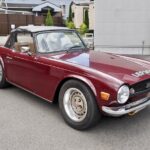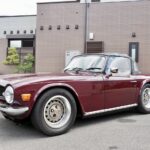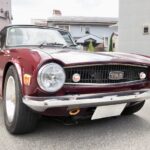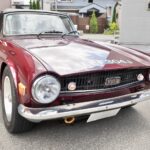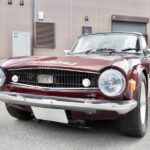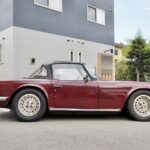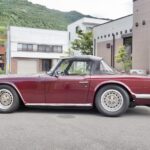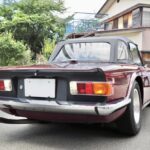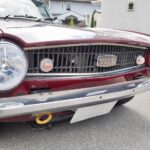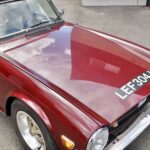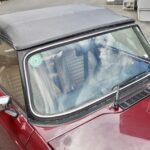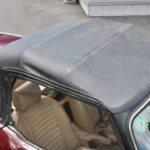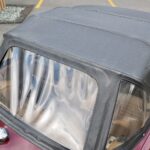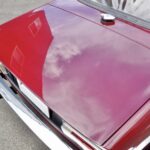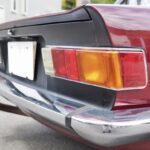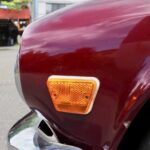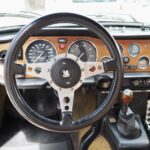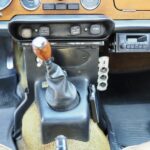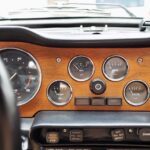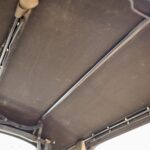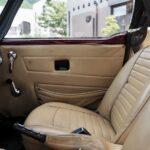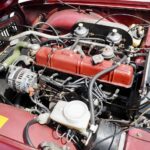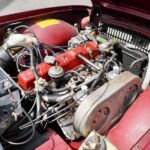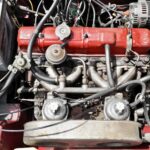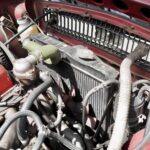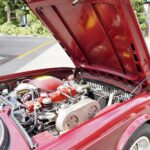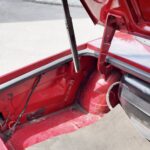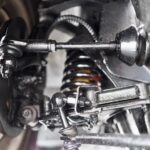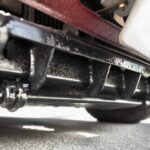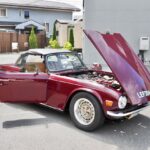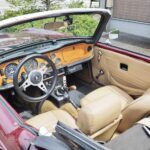TOP>Stock List>1975model Triumph TR6
1975model
Triumph TR6
↑↑↑Please watch the archived video above with audio if possible...
One’s heart is irresistibly captured by this rare grand tourer — a British creation born from the fusion of Italian aesthetics and German realism…! The 1975 Triumph TR6 is a machine where the big torque of its inline-six engine and its crisp, dry exhaust note merge seamlessly with the wind itself—an experience of pure driving harmony.
“It’s something that simply cannot be expressed without being drawn by hand… a kind of design that will never again emerge in today’s CAD-driven automotive world.”
Under the blazing midsummer sun, the Triumph’s original color — Damsen Red, so emblematic of the marque — glistens in the sunlight, while the flowing, sensuous lines of Michelotti’s hand-drawn long nose transform moment by moment. Simply watching these subtle shifts in expression leaves one deeply moved…
Along its sides, the TR6 retains echoes of 1960s British car design, where the rear fenders rise with a sense of voluptuous volume. Yet it is the tail end that delivers the car’s greatest visual statement. Here lies the TR6’s signature — the virtual long-tail “Coda Tronca” treatment. By abruptly truncating the elegantly flowing tail, the design reduces drag and streamlines the turbulent air behind the car — a perfect symbol of Italian elegance, harmonizing aerodynamics and sculptural beauty in one inspired gesture.
The owner, who had long harbored a strong admiration for British cars since his student days, originally considered icons such as the MG or Spitfire, but ultimately, it was the sensual sound of the British inline-six that captured his heart — the voice of this very Triumph TR6.
He acquired this 1975 example more than twenty years ago.
At the time, the engine was reluctant to start, and there were various issues with the fuel and electrical systems.
“The condition wasn’t great in the beginning — the engine was unstable, and I had to go through the entire fuel and electrical systems. But now that I think about it, all of that was part of the joy of living with this car,” he said, eyes narrowing fondly as he gazed at his TR6 — a look that spoke volumes.
His wife, too, once drove a classic Mini, and the two often worked on the TR6 together in the garage or went out for drives.
“When we drive with the top down, everything — the wind, the sound — feels so special!” he said, with a romantic smile.
At times, the couple even embarked on long drives to Hokkaido, enjoying perfect journeys and collecting countless joyful memories with this TR6.
This is a TR6 that has been lovingly maintained for over two decades, cared for like a member of the family.
In it, one sees not merely an old British sports car, but the living record of a passion — a life spent savoring the art, design, and culture of the automobile itself.
In the next chapter, we will trace the roots of that spirit — exploring the heritage of the Triumph name and the lineage of the TR6, to delve even deeper into the story of this irreplaceable machine…
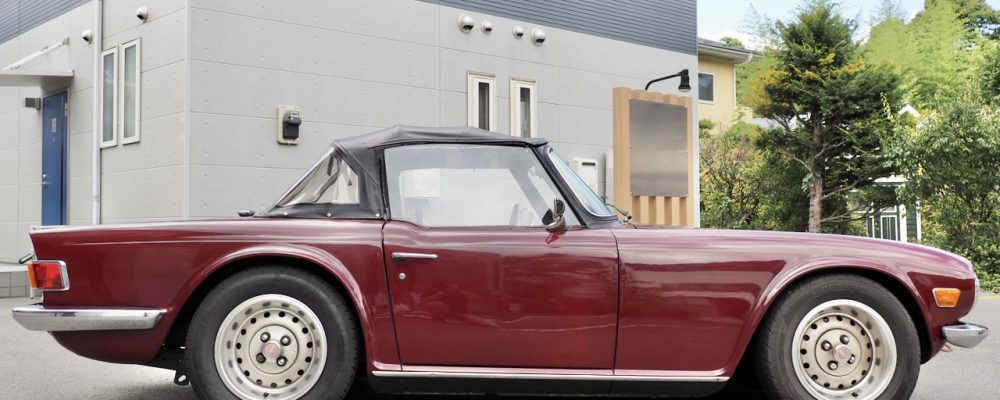
The Lineage of Triumph and the Birth of the TR6 — A British grand tourer born in the delicate balance between Michelotti’s aesthetic sensibility and Karmann’s pragmatic realism: the final evolutionary form of the Triumph tradition…
When speaking of postwar British sports car history, one simply cannot leave out the name Triumph.
The origin of the Triumph TR series traces back to 1953, with the debut of the TR2 — a car created to satisfy a growing demand for a higher-performance, more refined grand tourer in a market dominated by the likes of Austin-Healey and MG.
From the TR2 to the TR4 — The Birth of a New Design Language
From the moment of its birth, the TR series quickly became a cultural symbol of British motoring.
The TR3 introduced front disc brakes and earned overwhelming success in rally competitions. Then, with the 1961 TR4, Triumph underwent a dramatic stylistic transformation, marking the end of traditional British design language and the beginning of something altogether new.
But why did Triumph entrust the design of the TR4 to Giovanni Michelotti?
Triumph’s Italian Turn — Giovanni Michelotti and the International British Sports Car
By the late 1950s, Triumph was rapidly expanding its postwar sports car presence, particularly in North America.
The early models — TR2 (1953) and TR3 (1955) — featured sturdy ladder frames and minimalist side-curtain roadster bodies, earning fame as “tough, fast British cars.”
However, by the end of the decade, modernization was sweeping the global sports car scene. Cars like the Jaguar E-Type, MG A, and Alfa Romeo Giulietta Spider introduced refined styling and greater comfort, setting new standards.
Sir John Black, Triumph’s president at the time, recognized this shift.
He firmly believed Triumph had to evolve from a traditional roadster into a grand tourer infused with Italian modernism.
The answer came through a partnership with Italian maestro Giovanni Michelotti.
In 1957, Triumph commissioned Michelotti to design a prototype coupe based on the TR3.
That car became the TRS (S for Sports), which went on to compete at Le Mans, proving Triumph’s potential on the world stage.
Encouraged by the results, Triumph formally entrusted Michelotti with the styling of the production TR4.
The TR4 would become the first British car to truly fuse Italian aesthetics with British engineering, creating a new “international British sports car” — a design DNA that flowed directly through to the TR6 years later.
TR5 — Engineering Innovation and the First British 150hp Road Car
The TR4’s bold, straight-line design — the flat hood, pronounced fenders, and elegant pressed side line — was groundbreaking for its time.
It gave the TR series not only the image of a “sports car,” but the dignity of a true Grand Tourer (GT).
The TR5 carried Michelotti’s design language forward while advancing mechanically.
Its 2.5-liter inline-six OHV engine, equipped with Lucas mechanical fuel injection, made it the first British production sports car to achieve 150 horsepower — an extraordinary milestone of the 1960s.
The Transition to TR6 — From Michelotti to Karmann
But the late 1960s brought new challenges — the oil crisis, corporate restructuring, and regulatory shifts.
With the creation of British Leyland in 1968, Triumph’s development resources were severely constrained.
Michelotti himself had moved on to other projects, leaving no capacity for a full redesign.
Thus, Triumph adopted a pragmatic approach: they retained the TR5’s chassis and central body while commissioning the German coachbuilder Karmann to restyle the front and rear ends.
Karmann — known for the Volkswagen Karmann Ghia — added modern, linear surfaces to Michelotti’s graceful side profile.
The result was a stunning synthesis of Italian elegance and German rationality, producing the TR6 — a car that represented the final and most mature expression of classic British design.
Its long, flowing nose, short rear deck, and Coda Tronca-style truncated tail created a “virtual long tail,” improving aerodynamics while maintaining sculptural beauty — the essence of 1960s Italian design filtered through British craftsmanship.
The Heart of the TR6 — The Last of the True British Sixes
At its core, the TR6 carried Triumph’s signature 2.5-liter inline-six OHV engine, derived from the TR5.
While displacement remained the same, the characteristics changed significantly.
The British TR5 retained Lucas fuel injection and 150bhp, but for the U.S. market, Triumph replaced it with twin Zenith-Stromberg CD175 carburetors to meet emissions standards.
Output dropped to 104bhp, but torque delivery became smoother and more abundant at low rpm — perfectly suited for real-world grand touring.
And indeed, it is this engine that defines the TR6 experience — an engine that will never again be built.
Beneath its aluminum rocker cover lies a cast-iron block — simple, rugged, and full of mechanical soul.
The pushrod OHV layout may seem primitive by modern OHC standards, but its metallic density and tactile feedback offer a mechanical intimacy unmatched by later engines.
As the crankshaft rises gently in revs, the steel exhaust releases a mellow, harmonically rich note — the very essence of the British Six, resonating deep within the driver’s chest.
This 1975 example is perfectly tuned, its twin Stromberg carburetors synchronized to perfection.
At the press of the throttle, torque surges thickly through the midrange, accompanied by a supple yet dry exhaust note that pushes you gently but irresistibly forward.
This is not a car to be wrung out to 6000rpm with furrowed brows and white knuckles — far from it.
Rather, between 2000 and 4000rpm, where torque flows freely, it reveals its true nature as a grand touring engine, whispering to the driver:
“You’ll never see another engine like this again.”
Driving Feel — A Mechanical Symphony of the 1970s
Simply gazing at the classic British Six nestled beneath its low bonnet is an aesthetic experience in itself.
The symmetrical layout — twin carburetors on the right, neatly routed cooling and heater lines — resembles an industrial design sculpture.
And when the hood is closed, the way the flowing lines converge so elegantly is pure art — one of the subtle pleasures of TR6 ownership.
The transmission is a sturdy four-speed manual with overdrive, engaging in both 3rd and 4th gears.
Each short-throw shift clicks into place with a precise metallic “clack,” while the slightly heavy but reassuring clutch engages smoothly, blending the engine’s sonorous note with the rush of wind in one harmonious sensation.
Its chassis, based on Triumph’s backbone frame design and equipped with independent suspension (from the TR4A onward), provides excellent traction and composure through corners.
The front double wishbone and rear semi-trailing arm suspension deliver that uniquely British supple, communicative ride that makes the TR6 so rewarding to drive.
Front disc brakes and rear drums provide direct hydraulic feedback — sharp, linear, and organic.
In a world without ABS, every inch of pedal pressure translates directly into deceleration, bringing the driver and machine into perfect unity.
The Spirit of TR6 — The Final Evolution of “Beauty and Function in Harmony”
In essence, the TR6 is not an especially fast car — nor does it need to be.
It is not a machine for tense, hard-edged driving, but rather a car that transforms every sound, every vibration, and every gear shift into a celebration of motion itself.
The metallic resonance, the breathing of the twin carburetors, the tactile feel of the transmission — all combine to turn driving into pure pleasure.
That is the philosophy of motion embedded within the TR6 — the final evolution of the golden age of British motoring, where the legacy of Michelotti’s artistry and Karmann’s rational design converge in a perfect harmony of beauty and function.
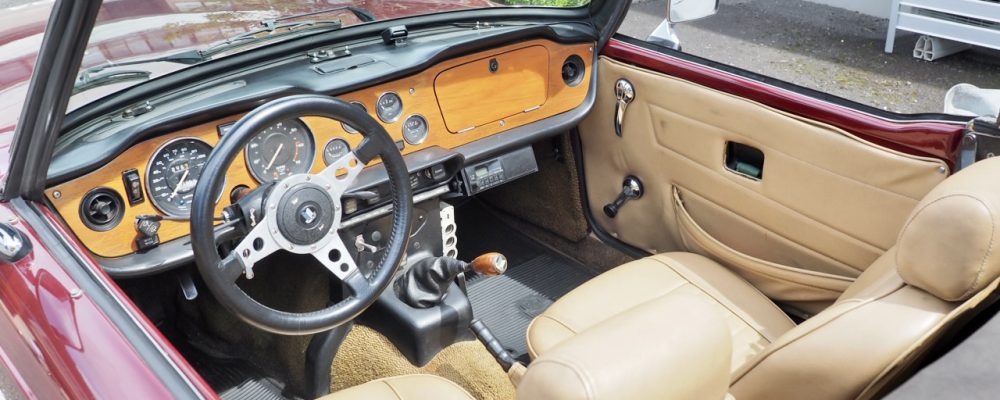
For more than twenty years under the care of its current owner… Let us now take a close, unhurried look at this 1975 Triumph TR6, finished in the rich and elegant Damsen Red—a car that embodies two decades of devotion and craftsmanship.
The deep burgundy hue tinged with brown—Triumph’s own Damsen Red—beautifully fuses British tradition with Italian elegance, a color tone that perfectly symbolizes the era and cultural sensibility from which this car emerged.
A Glimpse into Authenticity
Chassis number: CF35089UO
This 1975 Triumph TR6, built as a left-hand-drive North American export model, stands as a living testament to why the TR6 is often regarded as Triumph’s final great success in the export market.
The original steel bodywork presents itself with remarkable integrity: panel surfaces remain straight and true, free from dents or distortions. Only a few small areas of surface rust are visible on the right front fender, but overall the panels align beautifully, and the crisp fender lines flow with an elegance that defies its half-century age.
No signs of corrosion or structural fatigue can be found, and the car retains a fresh, vibrant condition rare for its vintage.
The Heart of the Machine
Lifting the bonnet reveals Triumph’s own 2498cc inline-six OHV engine, a work of mechanical honesty and balance.
Six precisely aligned intake ports sit atop the block, managed by twin Zenith-Stromberg carburetors—a hallmark of this era of Triumph engineering.
Ignition and fueling are perfectly tuned; the engine fires immediately at the turn of the starter, awakening with a crisp, dry exhaust note that resonates beautifully in the midrange.
Carburetor synchronization is ideal, resulting in a steady idle and smooth, linear throttle response. A light blip of the pedal brings forth the thick surge of midrange torque, accompanied by the mechanical hum unique to pushrod OHV engines—the distilled essence of a true British sports car.
Undercarriage and Suspension
The chassis has been carefully coated in protective black underseal, preserving its integrity. The underside is exceptionally clean and solid.
Equipped with independent suspension—double wishbones in the front and semi-trailing arms in the rear—the car delivers a light, communicative steering feel and responds with precision to driver input.
All suspension components and linkage points have been meticulously maintained, giving the car a taut, composed ride that defies its age of over fifty years.
Wheels, Tires, and Presence
It rides on original 15-inch steel rims fitted with tall-profile tires (215/65R15), striking a perfect balance between grand-touring stability and supple ride comfort, all while preserving its classic proportions.
The original wheel covers remain intact, with only one showing a minor crack—an impressive testament to the car’s preservation.
Interior — The Timeless British Touch
Inside, the original tan leather seats exude a soft, natural sheen, with minimal wear or cracking.
The Smiths instrumentation, framed by warm wood veneer trim, reflects a masterful harmony of British rationality and craftsmanship.
The layout is elegant yet purposeful, and every dial and switch functions with tactile satisfaction.
The chrome bezels still gleam brilliantly, and the large toggle switches—designed to be operated even with driving gloves—retain their solid, mechanical feel.
Every lever, knob, and control continues to breathe life, conveying the unmistakable vitality of analog motoring.
The convertible top and rear screen remain clear and supple, their operation light and precise.
The trunk interior is clean and beautifully preserved, with original paintwork intact and no signs of corrosion even in the spare wheel well.
Overall, this example represents an ideal, authentic condition, unified in originality from exterior to interior—a Triumph TR6 that stands as a truly timeless expression of British engineering and international design harmony.
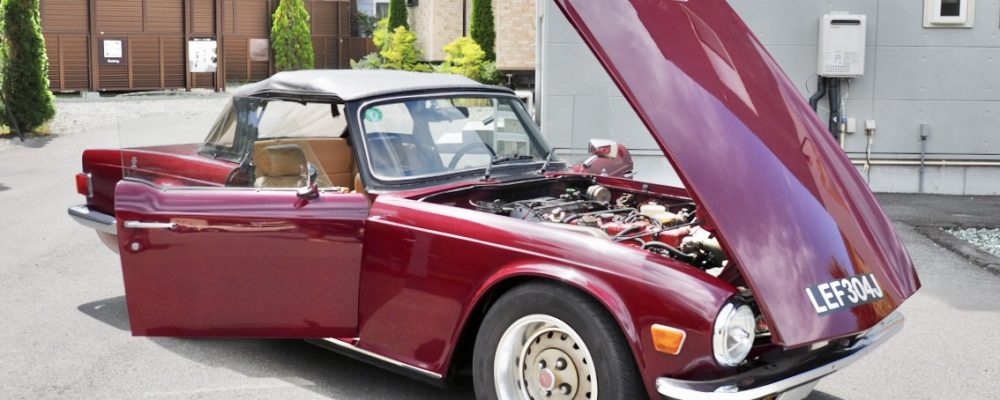
Postscript of the Author — 1975 Triumph TR6
During the interview, one comment from the owner left a particularly strong impression on me:
“I’ve loved the design of the TR6 and have lived with it for over twenty years…
While it still carries the influence of Michelotti, the bonnet lines and the shape of the tail feel slightly more modern.
To me, it holds all the essence of what makes a Triumph, right to the very end.”
Born at the crossroads where Michelotti’s artistry meets Karmann’s realism, the Triumph TR6 represents the final evolutionary form of the British grand tourer.
It is a machine whose beauty lies not only in its proportions, but also in the story of one man who devoted much of his life to it.
And yet — as time moves on, so too does life, and even the parting from a beloved car eventually becomes reality.
While I was writing this very article, the owner welcomed the birth of a new family member (my heartfelt congratulations!).
At this natural turning point — a change in life stage that comes to everyone — he made the heartfelt decision to part with his 1975 Triumph TR6, a car he had treated as family for two decades.
Even during the photo shoot, the owner would take every spare moment to gently polish the car’s bodywork.
Though he had resolved to let it go, one could sense that he hoped for a meaningful encounter with a new owner — someone who would inherit the same feelings and continue the story.
Surely, when that moment comes, he will know in his heart:
“Yes — this is the right person to entrust it to.”
One’s heart is irresistibly captured by this rare British-born grand tourer, where Italian aesthetics and German realism are seamlessly fused into one…! The 1975 Triumph TR6—a car in which the big torque of its inline-six engine and the crisp, dry exhaust note merge perfectly with the wind itself—stands as a true embodiment of mechanical poetry in motion.
We warmly invite you to come and see this remarkable Triumph TR6 in person — a rare opportunity to experience firsthand the passion and devotion of its owner.
As this is a private sale, no consumption tax or additional dealer fees will apply.
Upon purchase, the buyer will be responsible for the pro-rated automobile tax (annual rate: ¥51,750).
Since the recycling deposit has not been prepaid, no recycling fee settlement will be required.
Transportation and delivery arrangements should be made by the buyer; however, as part of my professional operations, I also offer classic car transport services using my company’s own carrier truck. Please feel free to contact me if you wish to make use of this service.
[For Inquiries]
This vehicle is featured on Estate Sale Supremacy®, a cross-border e-commerce platform specializing in classic and collectible cars.
What is “Estate Sale Supremacy®”?
“Estate Sale Supremacy®” represents the Japanese interpretation of the North American cultural tradition of the estate sale — introducing cherished vehicles through owner interviews, detailed written features, and video presentations.
We faithfully convey the thoughts and memories of the current owner, helping to ensure that each vehicle — rich in personal history — is passed on with integrity to the next generation through careful guidance and brokerage support.
We conduct detailed interviews with each owner regarding maintenance records, repair history, and accident history.
If a vehicle has experienced a major accident or if the ownership history is too brief to confirm details, we decline coverage entirely — all in an effort to provide buyers with maximum peace of mind.
This article was written based on an interview conducted on September 6, 2025, under clear skies, beginning at 10:00 a.m. and lasting approximately three hours.
Please note that, due to the limited inspection time, the description may not represent the vehicle’s condition with absolute precision, and not all statements have been independently verified.
Any comments regarding condition are based on the author’s subjective impressions under the specific weather and circumstances at the time of the interview.
For questions regarding this listing or to arrange an in-person viewing, please contact us via the link at the bottom of this page.
As this is a private transaction, and to avoid casual inquiries, vehicle inspections are strictly reserved for those who are seriously considering a purchase.
Thank you very much for your kind attention and thoughtful consideration.








